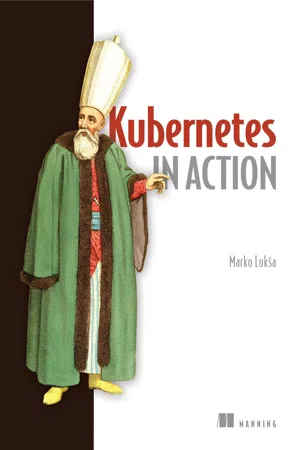
- 624 pages
- English
- ePUB (mobile friendly)
- Available on iOS & Android
Kubernetes in Action
About this book
Summary Kubernetes in Action is a comprehensive guide to effectively developing and running applications in a Kubernetes environment. Before diving into Kubernetes, the book gives an overview of container technologies like Docker, including how to build containers, so that even readers who haven't used these technologies before can get up and running.Purchase of the print book includes a free eBook in PDF, Kindle, and ePub formats from Manning Publications. About the Technology Kubernetes is Greek for "helmsman, " your guide through unknown waters. The Kubernetes container orchestration system safely manages the structure and flow of a distributed application, organizing containers and services for maximum efficiency. Kubernetes serves as an operating system for your clusters, eliminating the need to factor the underlying network and server infrastructure into your designs. About the Book Kubernetes in Action teaches you to use Kubernetes to deploy container-based distributed applications. You'll start with an overview of Docker and Kubernetes before building your first Kubernetes cluster. You'll gradually expand your initial application, adding features and deepening your knowledge of Kubernetes architecture and operation. As you navigate this comprehensive guide, you'll explore high-value topics like monitoring, tuning, and scaling. What's Inside
- Kubernetes' internals
- Deploying containers across a cluster
- Securing clusters
- Updating applications with zero downtime
About the Reader Written for intermediate software developers with little or no familiarity with Docker or container orchestration systems. About the Author Marko Luksa is an engineer at Red Hat working on Kubernetes and OpenShift. Table of Contents
PART 1 - OVERVIEW
- Introducing Kubernetes
- First steps with Docker and Kubernetes
PART 2 - CORE CONCEPTS
- Pods: running containers in Kubernetes
- Replication and other controllers: deploying managed pods
- Services: enabling clients to discover and talk to pods
- Volumes: attaching disk storage to containers
- ConfigMaps and Secrets: configuring applications
- Accessing pod metadata and other resources from applications
- Deployments: updating applications declaratively
- StatefulSets: deploying replicated stateful applications
PART 3 - BEYOND THE BASICS
- Understanding Kubernetes internals
- Securing the Kubernetes API server
- Securing cluster nodes and the network
- Managing pods' computational resources
- Automatic scaling of pods and cluster nodes
- Advanced scheduling
- Best practices for developing apps
- Extending Kubernetes
Frequently asked questions
- Essential is ideal for learners and professionals who enjoy exploring a wide range of subjects. Access the Essential Library with 800,000+ trusted titles and best-sellers across business, personal growth, and the humanities. Includes unlimited reading time and Standard Read Aloud voice.
- Complete: Perfect for advanced learners and researchers needing full, unrestricted access. Unlock 1.4M+ books across hundreds of subjects, including academic and specialized titles. The Complete Plan also includes advanced features like Premium Read Aloud and Research Assistant.
Please note we cannot support devices running on iOS 13 and Android 7 or earlier. Learn more about using the app.
Information
Table of contents
- Kubernetes in Action
- Copyright
- Brief Table of Contents
- Table of Contents
- front matter
- Part 1. Overview
- Chapter 1. Introducing Kubernetes
- Chapter 2. First steps with Docker and Kubernetes
- Part 2. Core concepts
- Chapter 3. Pods: running containers in Kubernetes
- Chapter 4. Replication and other controllers: deploying managed pods
- Chapter 5. Services: enabling clients to discover and talk to pods
- Chapter 6. Volumes: attaching disk storage to containers
- Chapter 7. ConfigMaps and Secrets: configuring applications
- Chapter 8. Accessing pod metadata and other resources from applications
- Chapter 9. Deployments: updating applications declaratively
- Chapter 10. StatefulSets: deploying replicated stateful applications
- Part 3. Beyond the basics
- Chapter 11. Understanding Kubernetes internals
- Chapter 12. Securing the Kubernetes API server
- Chapter 13. Securing cluster nodes and the network
- Chapter 14. Managing pods’ computational resources
- Chapter 15. Automatic scaling of pods and cluster nodes
- Chapter 16. Advanced scheduling
- Chapter 17. Best practices for developing apps
- Chapter 18. Extending Kubernetes
- Appendix A. Using kubectl with multiple clusters
- Appendix B. Setting up a multi-node cluster with kubeadm
- Appendix C. Using other container runtimes
- Appendix D. Cluster Federation
- Kubernetes resources covered in the book
- Index
- List of Figures
- List of Tables
- List of Listings